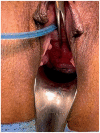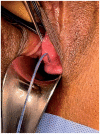Formation of vesicovaginal fistula after modified McDonald cerclage placement: a case report with literature review
- PMID: 38405422
- PMCID: PMC10893839
- DOI: 10.1177/17562872241232581
Formation of vesicovaginal fistula after modified McDonald cerclage placement: a case report with literature review
Abstract
Cervical cerclage is a common procedure employed to prevent preterm birth in women with cervical insufficiency. Complications such as injuries to the cervix and bladder, and premature membrane rupture are well-documented, while genitourinary fistulas are a rare occurrence. This article reports a rare case of vesicovaginal fistula (VVF) formation in a 27-year-old woman following the placement of a McDonald cervical cerclage. The patient presented with continuous watery vaginal leakage, which began during the last 2 months of her pregnancy. Clinical and cystoscopic examinations revealed the presence of a VVF, which was further confirmed through voiding cystourethrography and perineal magnetic resonance imaging. Notably, the patient had undergone the cerclage procedure 18 months prior to the onset of symptoms, making this case particularly unusual. We believe that the VVF formation was associated with the use of Mersilene tape, which may have slowly eroded through the cervix and subsequently breached the urothelium. This case underscores the importance of considering cerclage-related genitourinary fistulas as potential complications, especially when evaluating and counseling patients who have undergone cervical procedures like the McDonald technique. In conclusion, this case highlights the need for vigilant monitoring and a high index of suspicion in patients presenting with symptoms of genitourinary fistulas after such procedures. Further research and awareness in this area are warranted to better understand the risk factors and mechanisms underlying this unusual complication.
Keywords: bladder fistula; cervical cerclage; urine incontinence; urogenital fistula; vaginal fistula; vesicovaginal fistula.
Plain language summary
Our patient presented with continuous watery leakage that started during the last 2 months of her pregnancy. The patient was diagnosed with an abnormal communication between the bladder and vagina following the placement of cervical Mersilene tape. After 18 months, the opening was repaired, and the patient fully recovered 2 months after surgery. Complications associated with cerclage are rare and commonly related to injuries to the cervix or bladder, premature rupture of membranes, chorioamnionitis, and bleeding, as described in published reports. This case report described the unusual complication of vesicovaginal fistula formation after the placement of a McDonald suture. We emphasize that vesicovaginal fistula can have a serious impact on social, mental, and sexual health. Any practitioner dealing with such patients should be aware of these associated health problems during management.
© The Author(s), 2024.
Conflict of interest statement
The authors declare that there is no conflict of interest.
Figures
Similar articles
-
Genitourinary Fistulas After Cerclage: A Case Series and Scoping Review.Urogynecology (Phila). 2025 Apr 3. doi: 10.1097/SPV.0000000000001680. Online ahead of print. Urogynecology (Phila). 2025. PMID: 40179040
-
Unique complication of a Shirodkar cerclage: remote formation of a vesicocervical fistula in a patient with the history of cervical cerclage placement: a case report and literature review.Female Pelvic Med Reconstr Surg. 2013 Sep-Oct;19(5):306-8. doi: 10.1097/SPV.0b013e3182996cee. Female Pelvic Med Reconstr Surg. 2013. PMID: 23982583
-
Vesicovaginal fistula formation after cervical cerclage mimicking premature rupture of membranes.Obstet Gynecol. 2007 Feb;109(2 Pt2):493-4. doi: 10.1097/01.AOG.0000247291.00155.88. Obstet Gynecol. 2007. PMID: 17267870
-
Complications Associated with Cervical Cerclage: A Systematic Review.Gynecol Minim Invasive Ther. 2023 Feb 9;12(1):4-9. doi: 10.4103/gmit.gmit_61_22. eCollection 2023 Jan-Mar. Gynecol Minim Invasive Ther. 2023. PMID: 37025444 Free PMC article. Review.
-
Ureterovaginal fistula after insertion of a McDonald suture: Case report and review of published reports.J Obstet Gynaecol Res. 2015 Jul;41(7):1129-32. doi: 10.1111/jog.12671. Epub 2015 Feb 6. J Obstet Gynaecol Res. 2015. PMID: 25654991 Review.
References
-
- Mann WJ, Arato M, Patsner B, et al.. Ureteral injuries in an obstetrics and gynecology training program: etiology and management. Obstet Gynecol 1988; 72: 82–85. - PubMed
-
- Graber EA, O’Rourke JJ, Mcelrath T. Iatrogenic bladder injury during hysterectomy. Obstet Gynecol 1964; 23: 267–273. - PubMed
-
- Harger JH. Cerclage and cervical insufficiency: an evidence-based analysis. Obstet Gynecol 2002; 100: 1313–1327. - PubMed
-
- Hortenstine JS, Witherington R. Ulcer of the trigone: a late complication of cervical cerclage. J Urol 1987; 137: 109–110. - PubMed
-
- Sobande AA, Archibong EI, Sadek A, et al.. A clinico-epidemiological review of cervical cerclage from the Assir region of Saudi Arabia. J Obstet Gynaecol 2002; 22: 150–154. - PubMed
Publication types
LinkOut - more resources
Full Text Sources




